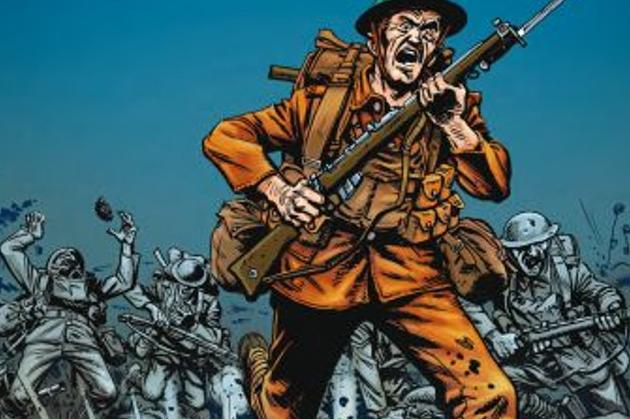CHARLEY'S WAR, VOL 1 REVIEW
Writer: Pat Mills
Artist: Joe Colquhoun
Letterers: John Aldrich; Jim Campbell
Publisher: Rebellion
With the Great War raging, a young man named Charley Bourne volunteers to join the British army, eager to do his patriotic duty. Despite being underage Charley finds himself in the trenches, arriving just in time to witness the slaughter that was the Battle of the Somme.
Charley’s War was originally published in Battle Picture Weekly, a British anthology comic that featured action packed war stories. Appearing each week in three or four page episodes, Charley’s War ran from 1979 to 1986, following the character of Charley Bourne through the Great War as a naive young man, and into the early years of the Second World War as a father. This truly epic saga has been reprinted several times, in various different formats, to great critical acclaim. Charley’s War Volume 1 collects the first 86 episodes, and will be followed by Volumes 2 and 3 later this year.
The Battle of the Somme was a major assault that began in July 1916. The Allies and Germans had reached a stalemate, with hundreds of thousands of troops literally entrenched along an extended front. The decision was made that, following heavy shelling of the German front line, the British and French army would push forward in the Somme region, with soldiers ordered to walk in an orderly fashion across no man’s land to capture the German trenches. Unbeknown to Allied command, the shelling was largely unsuccessful in destroying German defences, and those men were being ordered to walk to their deaths. On the first day of the battle, more than 60,000 men were killed or seriously injured. The assault continued until November 1916 and resulted in almost a million casualties in exchange for a few miles of land.
Charley’s War tells this story by going beyond statistics and telling of the men who fought and died. We follow Charley from idealistic young man, who kills enemy soldiers through desperation and fear, into an experienced soldier, filled with a grief fuelled rage. A form of narration is provided in Charley’s letters to home, where a young man who has difficulty grasping the horrors that surround him tries to conceal his fears from his loved ones. In heart wrenching scenes, images of men being machine gunned play out against letters about football matches. An aging aunt complains about her aches and pains, whilst Charley tries to prevent a friend from shooting himself in the foot in a desperate attempt to be sent home - a crime on the frontline for which men were executed.
The story takes Charley from going “over the top” on the first day of the Battle, to witnessing the last cavalry charge undertaken by the British Army, the first use of tanks on the battlefield, suffering through a gas attack, and taking Charley home on leave, to a country broken by a war its people fail to understand.
We are provided with a cast of memorable characters who are sometimes caricatures, but frequently display hidden depths. The bellowing Sergeant with his waxed moustache and officious manner becomes a more interesting character when his very real fear, and his need to hide that fear, is shown. Meanwhile, the evil Officer Snell remains an exaggerated satire on the British class system. This blend of real and unreal not only reflects Charley’s own view of the world, but lends to the feeling that at any point any one of these characters could step up and reveal more about themselves. German soldiers are sometimes presented as unfeeling monsters, and then as victims. In a particularly striking scene, Charley and his friends capture a German soldier and realise that he’s just as frightened as they are. As they get to know him, a British officer appears and immediately shoots the unarmed captive in the head. Charley’s War is deeply political and it is made clear that this war isn’t just being fought between nations, but between humanity and inhumanity.
Incredibly detailed and evocative art from Joe Colquhoun captures the intense desperation of the trenches; of mud and corpses, of dead friends and constant fear and decay. There are countless small details which bring the environment and these people to life, that make us care about these characters and their survival. Watching Charley’s reaction at digging a hole and finding a dead body is startling, whilst his attempts at raising the morale of a man who knows he will die is uplifting. Charley’s blank faced shock following the death of his close friend is truly heartbreaking, and a realistic turning point for the character.
This version of Charley’s War Volume 1 features remastered art. With several different versions of the comic already in existence from previous reprints, Rebellion selected the best source for every page, some of which retained original machine lettering from the Battle Picture Weekly publication, and others which had been re-lettered at a later stage by John Aldrich. The ever reliable Jim Campbell re-lettered many of the pages, bringing the styles together across the whole volume, as well as subtly altering the art to fit the new word balloons. The re-master has been really well done, breathing new life into what were faded pages with some old fashioned and clunky machine lettering. The original feel of the art is retained, without the outdated lettering style, and with no clashing of styles.
Charley’s War is a 10/10 comic, but it's more than that. It is an extraordinarily touching work of art and literature, and a masterful example of what the medium is capable of.
(My thanks to Jim Campbell for his input on the remastering process. Information on Jim's technique and his work for a variety of publishing companies can be found on his blog clintflickerlettering.blogspot.co.uk)





